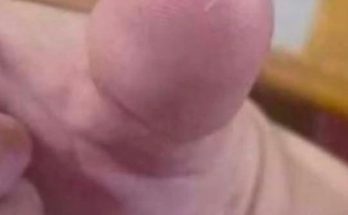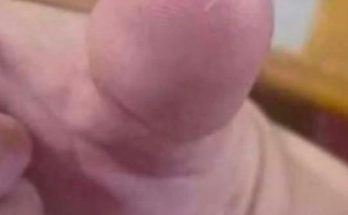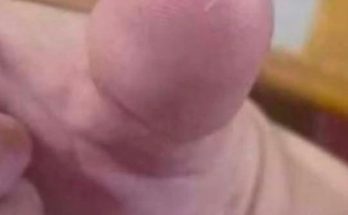Twelve buyers had examined and rejected it. The auctioneer, frustrated, lowered the price. A healthy slave cost $800; a horse, $50.
“I’ll give it to you for $10!” he shouted. Silence. “Five dollars!” A cruel laugh echoed. “I wouldn’t take it even for free!” shouted a farmer. “It’ll die before it even reaches my land.”
Ruth’s story was an eight-year nightmare. Sold as a child to a tobacco plantation in Virginia, she worked 18 hours a day.
Her hands were deformed, her nights were filled with a bloody cough, and, most devastatingly, she had dug the graves of her three young children with her bare hands; they had died of malnutrition.
Even the other slaves avoided her. “She’s got one foot in the grave,” they whispered.
But while everyone saw a broken woman waiting for death, something extraordinary was stirring behind those seemingly empty eyes.
Thomas Mitchell arrived at the market with $50. A widower for two years, he was struggling to keep his small store afloat and needed cheap labor. It was in the “waste” section where he saw Ruth.

The auctioneer, Moses Hartwell, scoffed. “She’s been here two months. Nobody wants her. Besides being sick, she’s rebellious. She tried to escape three times from the last plantation.”
Thomas noticed the scars, not just from whips, but from hot irons. “How much for her?” Thomas asked, more out of morbid curiosity than interest. “Two dollars, and you’ll still lose money,” Moses spat. “She won’t last the week.”
The other buyers laughed. But something in Ruth’s gaze intrigued Thomas. It wasn’t resignation; it was calculation. Against all logic, Thomas took out two silver coins and handed them to her.
“Deal,” Moses said. “You just threw two dollars away.”
As they walked, Ruth, who could barely stand, scanned the shops, memorizing prices in the windows. When they reached Thomas’s modest house behind the warehouse, he pointed out a small tool shed.
“Here’s just one task for you,” Thomas said, handing her a bowl of hot porridge. “Get well. You have to live first.”
He established a routine: three meals a day. For Ruth, who had survived on sour scraps, it seemed like a feast. The transformation was miraculous. Within a week, her wounds healed and her cough subsided.
But it was in the second week that Thomas noticed something extraordinary. Returning from some deliveries, he found the warehouse completely reorganized. The goods, previously scattered, were now arranged systematically: dry goods in one section, canned goods in another, tools grouped by size. Next to each category were small, hastily written notes with profit margin calculations.
“Ruth, did you do this?” She nodded shyly. “How do you know about profit margins?” “I observe, sir. I always have,” she replied.
Intrigued, Thomas began to test it. He would leave complex invoices and inventories on the desk. Upon returning, he would find corrections to errors he himself hadn’t noticed and suggestions for optimization.
The truth was revealed. During years of slavery, Ruth had transformed suffering into knowledge. While other slaves focused on survival, she observed her masters’ negotiations, calculated the profits from harvests, and memorized prices.
—At Master Jefferson’s plantation —Ruth said one day—, they lost 30% of their profits because they bought seeds at the wrong time.
Thomas froze. The woman he had bought for $2, hoping he would die, had analyzed complex business operations during years of silent torture.
One morning, Thomas found a sheet of paper on his desk. It was a detailed summary of his week’s transactions, written in handwriting that perfectly imitated his own. “Ruth,” he said, his heart racing. “Can you read and write?” She lowered her gaze, terrified. “Please don’t punish me, sir. I learned in secret, watching the white children’s lessons.”
Thomas understood the magnitude of the discovery. Ruth wasn’t just a rescued slave; she was a business genius in disguise.
Two months later, Ruth, who now weighed 50 kilos (110 pounds), approached Thomas as he struggled with the accounting books.
“Mr. Mitchell,” she said, her voice firm. “Your profits could easily triple. Give me six months to run this warehouse and I’ll prove it to you mathematically.”
Thomas laughed nervously. “You’re a failed trader,” she interrupted with brutal frankness. “You lose 40 percent of your profits because you buy the wrong products at the wrong times. You buy candles in the summer and run out of tools during planting season. Your prices are misaligned.”
Thomas was speechless. Every word was true. “What do you propose?” “First,” Ruth said, sitting down (something a slave would never do), “a system of wholesale purchases directly from the producers. Second, scheduled seasonal sales. Third, controlled credit for regular customers, with an interest rate.”
Ruth implemented her changes with the precision of a general. She negotiated with producers, securing prices 30% lower. She created a credit system that customers loved, paying a “convenience rate” of 10%.
The results were immediate. In the first month, revenue increased by 150%. In the second, by 200%. In the third month, the increase was 300%.
“Ruth,” Thomas said one night, counting a pile of money he’d never seen before, “this doesn’t make sense. You’re not my property. You’re my partner. I want you to keep half of the extra profits.”
“I accept,” Ruth said. “But on one condition. I want to buy my own freedom.” “How much would you pay for a slave with your skills?” Thomas calculated. “$1,200, easily.” “Then we have a goal,” Ruth said. “In six months, I will buy my own freedom.”
The next opportunity arose one afternoon near a military encampment. Ruth observed the Confederate soldiers. They were paying absurd prices for basic goods: 50 cents for a bar of soap that cost 10 cents at Thomas’s store.
“Mr. Mitchell,” Ruth said back, “they’re charging five times as much. I’m not suggesting we sell to military camps. I’m proposing we corner that market.”
With their savings, they bought a sturdy cart and hired two freed formerly enslaved men, Marcus and Samuel. But Ruth’s strategy was more sophisticated. She had studied what the soldiers desired most: perfumed soap, premium tobacco, and, above all, home-cooked food.
Ruth would wake up at 4 a.m. to bake cakes, bread, and cookies. They would leave before dawn.
“Apple pie like your mother used to make!” Ruth would shout. Demand was so high that they sold out before noon.
The numbers were spectacular. The first month, they earned $800 in net profit. The second, $1,200. The third, $2,000.
But Ruth’s true genius was espionage. As she wrapped the goods, she asked casual questions. “Where are they marching to next week? What supplies are missing at Colonel Johnson’s camp?”
The soldiers, captivated, shared everything. Ruth memorized troop movements and specific demands, creating a mental map of the military market. “Information is worth more than gold, Samuel,” she told her assistant. “And we’re collecting a fortune every day.”
The winter of 1846 arrived. Nine months after its purchase, Ruth Washington walked into Thomas Mitchell’s office carrying a worn leather suitcase. Inside was $1,200.
She placed the suitcase on the desk. “Mr. Mitchell, I would like to purchase a slave.” “Which slave do you wish to purchase, Ruth?” The answer came like a flash. “Myself.”
The silence was deafening. Thomas, his hands trembling, looked at the stacks of money. “Ruth,” he said, his voice breaking, “you don’t have to pay me. I’ll set you free.
You’re my friend.” “No, Mr. Mitchell,” she replied resolutely. “I want to buy my freedom to prove to the world, and to myself, that I’m worth every penny. I want it on the official record that Ruth Washington paid for her own freedom.”
It was an act of supreme dignity.
Freedom, achieved in December 1846, unleashed a hurricane of ambition. Ruth established a chain of five specialty stores across South Carolina: one for soldiers, one for farmers, one for women. She created the South’s first organized home delivery system, decades before it became commonplace.
The prejudice was brutal. White suppliers refused to sell to her; banks denied her loans. Her response was to create a network of “straw men”: poor white people who lent their names to businesses in exchange for monthly payments. Officially, they were the owners; in practice, Ruth controlled every penny.
When the Civil War broke out in 1860, Ruth saw the greatest opportunity of her life. She secured exclusive contracts to supply uniforms, boots, and rations to the Confederate army. Her strategy was audacious: she offered prices 30% lower, but demanded full payment upfront.
But Ruth did something more. Using her network of front men, she began secretly selling to the Union army as well. The same woman who supplied gray uniforms to the Confederates was sending blue equipment to the federal troops. It was a double-edged sword, but also extremely risky.
In 1863, she was nearly discovered. Investigators from both armies noticed suspicious similarities in the products. Ruth had to burn documents, bribe officials, and relocate entire operations in the middle of the night.
During those chaotic years, as the South disintegrated, Ruth implemented her final strategy. White plantation owners, ruined by the war, were selling their properties at absurdly low prices. Ruth acquired three entire plantations for only $5,000 each—properties that had previously been worth $50,000.
But instead of cotton or tobacco, Ruth transformed the land into diversified farms: vegetables, corn, cattle, and chickens. Desperately needed products.
He hired hundreds of newly freed slaves, offering them fair wages, decent housing, and education for their families. He created the first organized community of free Black workers in South Carolina.
By 1865, at the end of the war, Ruth Washington owned three productive plantations, twelve stores, and an estimated net worth of $200,000. This placed her among the wealthiest 5% of all South Carolina residents, regardless of race. Her fortune was greater than that of her former master.
That master was Robert Hayes, the owner of the tobacco plantation where Ruth had almost died. The man who had sold her for $2, considering her a waste of food.
In the fall of 1865, Hayes was a broken man. The war had taken everything from him. His plantation had been confiscated, and he survived by begging in Charleston.
When he heard the rumors about Ruth, the wealthiest Black woman in the city, he refused to believe them. But hunger got the better of him.
Ruth was inspecting one of her newly acquired fields when she saw a ragged man approaching along the dirt road. She immediately recognized those cold eyes.
Robert Hayes, holding his battered hat in his hand, asked for work in a humble voice, not recognizing her. “Miss Ruth, I… I need any job. Anything you can give me.”
Ruth looked at him in a silence that seemed like an eternity. Then, in a calm but firm voice, she asked, “Do you remember me, Master Hayes?”
The man frowned. Ruth continued. “I am Ruth. The slave you sold because I was nearly dead. The one who worked 18 hours a day on your tobacco plantation. The one you said wasn’t worth the food she ate.”
Robert Hayes’s face went completely white. His legs trembled as he finally recognized those determined eyes. The dying slave he had scorned for two pieces of silver now stood before him, landowner, elegantly dressed, radiating power.
Hayes fell to his knees, unable to speak.
Ruth watched him for a long moment, not with hatred, but with the cold calm of someone who has closed an impossible circle. She turned away and, without saying another word, continued inspecting her fields, leaving the ghost of her past trembling in the dust.



